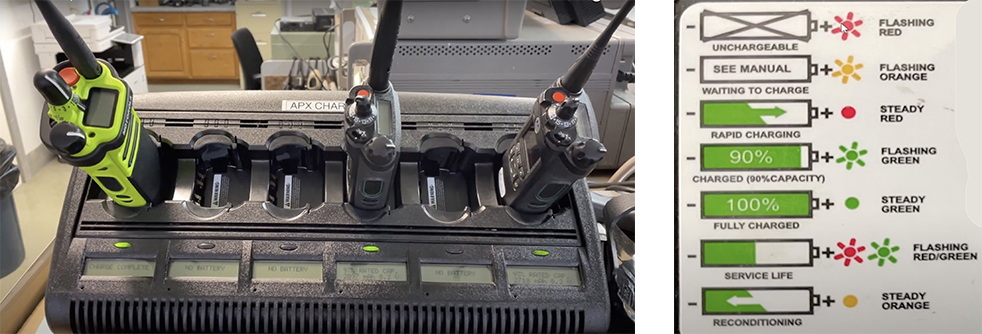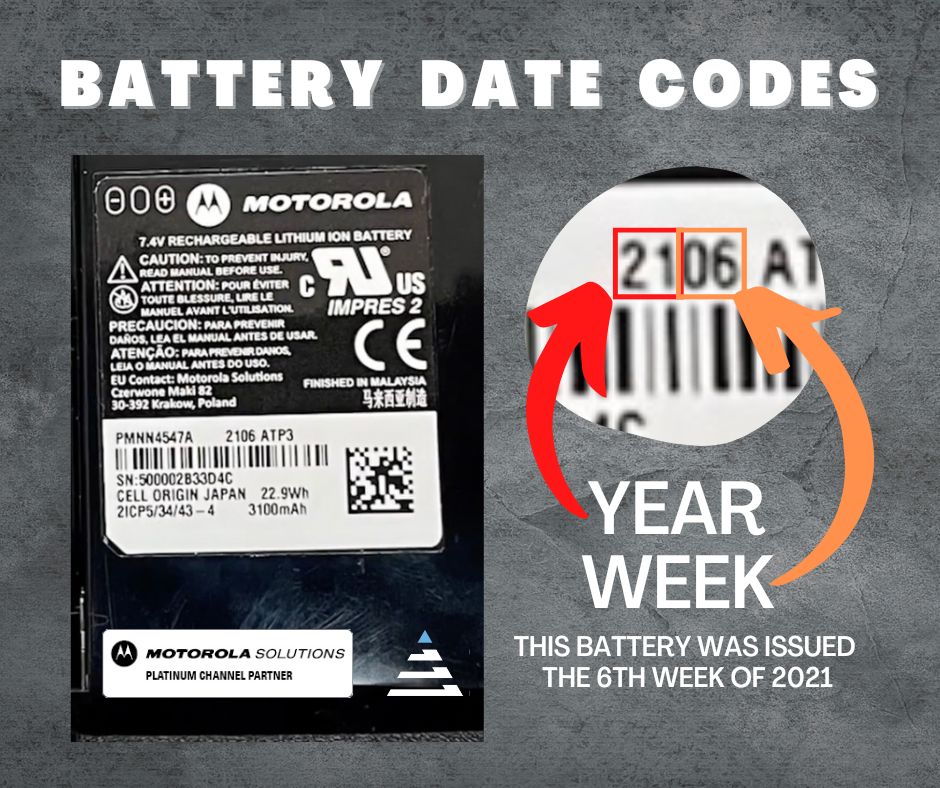KEEPING YOUR MOTOROLA TWO-WAY BATTERIES IN BEST WORKING ORDER
No matter what business you are in, communicating efficiently and quickly is your goal. Two-way radios are one of the best ways to stay in contact with your team, and the fuel for your radio fleet are batteries. Let’s get in to how these batteries charge, what date codes mean and what are the best practices to keeping your batteries in top working order.
Over the years Motorola batteries have evolved and basically have gotten smarter. The newer Motorola batteries actually have circuitry inside the battery that exchanges information with the charger. Because of this, it has taken all the guesswork out of your batteries life cycle and when the next recondition cycle will been. This has helped greatly to extend the life of Motorola batteries.
MULTI UNIT CHARGERS

When communication is important to how you perform your job, you need to be sure that your radio will be in top working order for the next 8 hours.
If you have a large fleet of radios a Multi-Unit Charger (MUC) is a must. These MUC units use different colored lights along with percentages and other facts to let you know important information about your battery such as the state of the charge, how many hours of usage are left, what the voltage of the battery is, when the charge is complete and more. By using the data from this charger, you can determine the service life of your radio.
DATE CODES

Managing your battery fleet armed with knowledge of how old your battery is also important in making sure you are communicating clearly day in and day out.
Each Motorola battery has a date code listed. Reading from left to right the first group of letters and numbers is the Model Number for that battery. The next set of numbers indicates the year and month of the battery (example June of 2021, will appear as 2106). This battery date code is important when discussing issues with the battery and how it is listed in the warranty.
The sweet spot for batteries is about two years. Batteries can perform longer than this period of time, but at that point you should be thinking of replacing them. Knowing these date codes can also help your administrators budget for what product your company will need to purchase in the coming year.
USING THE RIGHT BATTERY FOR YOUR RADIO
Motorola offers a variety of batteries with different sizes, capacities and environmental use conditions. It is important to use the right Motorola battery with your Motorola radio. Having the right battery and battery charger is important for the warranty of your Motorola batteries. Batteries and chargers do talk to each other. Each Motorola radio will list the type of batteries that should be used with that specific model. To keep your radio working at optimal performance and to be sure you do not void the warranty of your radio be sure to follow these guidelines
RECOMMENDATIONS FOR BATTERY USE, STORAGE AND CARE
Below are some simple, but important guidelines to follow for battery use, storage and care:
Initialize new batteries or batteries that have been stored for prolonged periods by charging overnight (16 hours).
Charge batteries every 6 months during prolonged storage.
Use a battery for at least 4 hours prior to recharging. Remember, each time the battery is charged, one life cycle is used, and a battery has limited number of life cycles.
Allow battery to reach room temperature (for at least 1 hour) before placing it in the charger. Charger temperature rage: 41° – 122.0° Fahrenheit. Do not fast-charge a cold battery. Charging a cold battery can cause excessive internal pressure, cell leakage and catastrophic failure. Do not charge a hot battery; if a battery is hot at the beginning of charge, charge efficiency will be greatly reduced. Nickel cadmium batteries are mot efficiently charged at room temperature.
Take batteries out of a charger when they are fully charged. Batteries allowed to remain in charger for extended periods lose valuable life cycles, Remember to conserve battery life cycles.
Choose the right battery for every application.
Do not force discharge nickel cadmium batteries beyond one volt per cell. Excessive deep discharge can significantly reduce battery life.
Do not use chemical cleaners to clean batteries. Clean batteries only with a mild soap and dry thoroughly with a cloth.
For more information, check out the links below or contact P&R Communications at 937-512-8100, info@pandrcommunications.com or www.pandrcommunications.com.
For more information check out the P&R Communications YouTube Channel for Battery Care
P&R Tech Tips | Batteries, Part 1
P&R Tech Tips | Batteries, Part 2